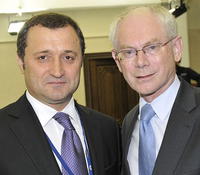In April 2009, Moldova, a former Soviet republic sandwiched between Romania and Ukraine, earned short-lived attention for post-election street riots that some dubbed a Twitter revolution. This brief eruption of popular discontent led some to expect another "color revolution" along the lines of those in Georgia in 2003 and Ukraine in 2004, both of which ushered in unwaveringly pro-Western governments and attracted immediate support from Washington and Brussels. While the riots in Moldova did not lead to an immediate change of government -- and had little to do with Twitter -- they did mark the beginning of the end for a generation of Moldovan ruling elites brought up in the Soviet system.
Since that time, Moldova has held two national elections, and a European-oriented coalition of parties has gained votes and seats in parliament both times. In fact, since the disputed April 2009 elections, the parliamentary balance of power has shifted from a strong old-guard majority, with then-President Vladimir Voronin's Communist Party holding 60 of 101 seats, to a 59-seat majority for the Alliance for European Integration (AEI) following elections in November. The alliance's three constituent parties range from conservative-nationalist to pragmatic-centrist, but all agree that Moldova's future lies in closer cultural, institutional and trade ties with Europe.
Although the magnitude of this political transition was similar to that of Georgia and Ukraine's color revolutions, and the change in the parliamentary balance of power exceeded that of the 2010 U.S. midterms, it has garnered relatively little attention from the West. In part, this may be because the AEI lacks a single charismatic leader and a sound-bite-friendly narrative. A deeper reason for the relative indifference to Moldova's reorientation has been its failure to overcome structural gridlock imposed by the requirement of a 61-vote supermajority in the parliament to select a president. Since no party or coalition has yet mustered the required votes, successive Moldovan governments have been without a permanent president for nearly two years.

